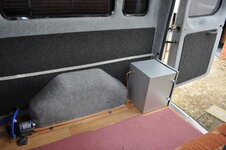- Nov 24, 2008
- 867
- 2,168
- Funster No
- 5,008
- MH
- C Class
- Exp
- Since july 2009 And Still Going Strong
For a while we are going to be using a butane 13kg bottle in our self build. What have others used as a cabinet? Have you brought or made your own? Ive seen a few made of thick ply, is that suitable or does it have to be sealed metal? Or have you just the bottle sitting in the back/under the hob etc.
Thanks
Shawn
Thanks
Shawn



